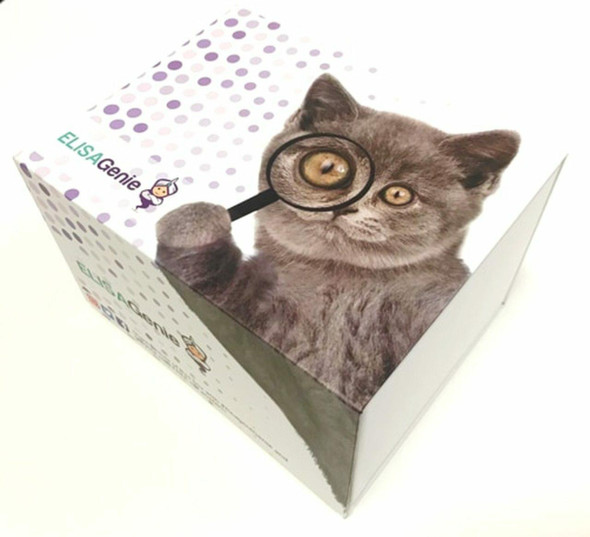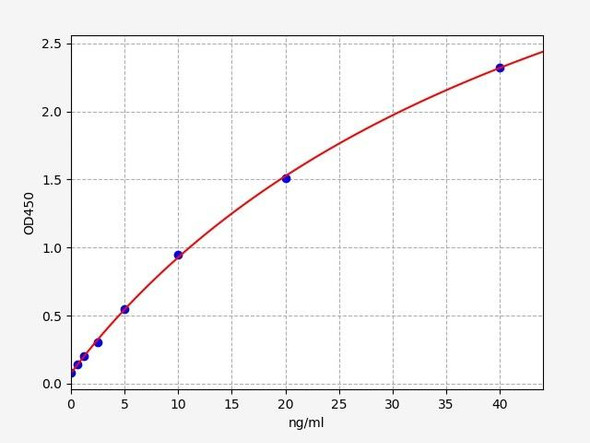Human Epigenetics and Nuclear Signaling ELISA Kits
Human VDR (Vitamin D Receptor) CLIA Kit (HUES01096)
- SKU:
- HUES01096
- Product Type:
- ELISA Kit
- ELISA Type:
- CLIA Kit
- Size:
- 96 Assays
- Sensitivity:
- 75pg/mL
- Range:
- 125-8000pg/mL
- ELISA Type:
- Sandwich
- Reactivity:
- Human
- Sample Type:
- Serum, plasma and other biological fluids
- Research Area:
- Epigenetics and Nuclear Signaling
Description
| Assay type: | Sandwich |
| Format: | 96T |
| Assay time: | 4.5h |
| Reactivity: | Human |
| Detection method: | Chemiluminescence |
| Detection range: | 125.00-8000 pg/mL |
| Sensitivity: | 75.00 pg/mL |
| Sample volume: | 100µL |
| Sample type: | Serum, plasma and other biological fluids |
| Repeatability: | CV < 15% |
| Specificity: | This kit recognizes Human VDR in samples. No significant cross-reactivity or interference between Human VDR and analogues was observed. |
This kit uses Sandwich-CLIA as the method. The micro CLIA plate provided in this kit has been pre-coated with an antibody specific to Human VDR. Standards or samples are added to the appropriate micro CLIA plate wells and combined with the specific antibody. Then a biotinylated detection antibody specific for Human VDR and Avidin-Horseradish Peroxidase (HRP) conjugate are added to each micro plate well successively and incubated. Free components are washed away. The substrate solution is added to each well. Only those wells that contain Human VDR, biotinylated detection antibody and Avidin-HRP conjugate will appear fluorescence. The Relative light unit (RLU) value is measured spectrophotometrically by the Chemiluminescence immunoassay analyzer. The RLU value is positively associated with the concentration of Human VDR. The concentration of Human VDR in the samples can be calculated by comparing the RLU of the samples to the standard curve.
| UniProt Protein Function: | VDR: Nuclear hormone receptor. Transcription factor that mediates the action of vitamin D3 by controlling the expression of hormone sensitive genes. Regulates transcription of hormone sensitive genes via its association with the WINAC complex, a chromatin-remodeling complex. Recruited to promoters via its interaction with the WINAC complex subunit BAZ1B/WSTF, which mediates the interaction with acetylated histones, an essential step for VDR-promoter association. Plays a central role in calcium homeostasis. Defects in VDR are the cause of rickets vitamin D- dependent type 2A (VDDR2A). A disorder of vitamin D metabolism resulting in severe rickets, hypocalcemia and secondary hyperparathyroidism. Most patients have total alopecia in addition to rickets. Belongs to the nuclear hormone receptor family. NR1 subfamily. |
| UniProt Protein Details: | Protein type:DNA-binding; Transcription factor; Nuclear receptor Chromosomal Location of Human Ortholog: 12q13. 11 Cellular Component: nucleoplasm; nucleus; receptor complex Molecular Function:retinoid X receptor binding; protein binding; DNA binding; zinc ion binding; sequence-specific DNA binding; steroid hormone receptor activity; vitamin D3 receptor activity; transcription factor activity Biological Process: lactation; transcription initiation from RNA polymerase II promoter; positive regulation of apoptosis involved in mammary gland involution; cell morphogenesis; decidualization; negative regulation of transcription from RNA polymerase II promoter; signal transduction; intestinal absorption; cellular calcium ion homeostasis; negative regulation of cell proliferation; calcium ion transport; steroid hormone mediated signaling; positive regulation of transcription from RNA polymerase II promoter; gene expression; negative regulation of transcription, DNA-dependent; skeletal development; positive regulation of keratinocyte differentiation Disease: Vitamin D-dependent Rickets, Type 2a; Osteoporosis |
| NCBI Summary: | This gene encodes the nuclear hormone receptor for vitamin D3. This receptor also functions as a receptor for the secondary bile acid lithocholic acid. The receptor belongs to the family of trans-acting transcriptional regulatory factors and shows sequence similarity to the steroid and thyroid hormone receptors. Downstream targets of this nuclear hormone receptor are principally involved in mineral metabolism though the receptor regulates a variety of other metabolic pathways, such as those involved in the immune response and cancer. Mutations in this gene are associated with type II vitamin D-resistant rickets. A single nucleotide polymorphism in the initiation codon results in an alternate translation start site three codons downstream. Alternative splicing results in multiple transcript variants encoding different proteins. [provided by RefSeq, Feb 2011] |
| UniProt Code: | P11473 |
| NCBI GenInfo Identifier: | 137617 |
| NCBI Gene ID: | 7421 |
| NCBI Accession: | P11473. 1 |
| UniProt Secondary Accession: | P11473,Q5PSV3, B2R5Q1, G3V1V9, |
| UniProt Related Accession: | P11473 |
| Molecular Weight: | |
| NCBI Full Name: | Vitamin D3 receptor |
| NCBI Synonym Full Names: | vitamin D (1,25- dihydroxyvitamin D3) receptor |
| NCBI Official Symbol: | VDR |
| NCBI Official Synonym Symbols: | NR1I1; PPP1R163 |
| NCBI Protein Information: | vitamin D3 receptor; 1,25-dihydroxyvitamin D3 receptor; vitamin D nuclear receptor variant 1; nuclear receptor subfamily 1 group I member 1; protein phosphatase 1, regulatory subunit 163 |
| UniProt Protein Name: | Vitamin D3 receptor |
| UniProt Synonym Protein Names: | 1,25-dihydroxyvitamin D3 receptor; Nuclear receptor subfamily 1 group I member 1 |
| Protein Family: | Vitamin D3 receptor |
| UniProt Gene Name: | VDR |
| UniProt Entry Name: | VDR_HUMAN |
As the RLU values of the standard curve may vary according to the conditions of the actual assay performance (e. g. operator, pipetting technique, washing technique or temperature effects), the operator should establish a standard curve for each test. Typical standard curve and data is provided below for reference only.
| Concentration (pg/mL) | RLU | Average | Corrected |
| 8000 | 68642 74236 | 71439 | 71418 |
| 4000 | 33665 37331 | 35498 | 35477 |
| 2000 | 17953 17155 | 17554 | 17533 |
| 1000 | 7843 9333 | 8588 | 8567 |
| 500 | 4268 3946 | 4107 | 4086 |
| 250 | 1895 1839 | 1867 | 1846 |
| 125.00 | 716 778 | 747 | 726 |
| 0 | 20 22 | 21 | -- |
Precision
Intra-assay Precision (Precision within an assay): 3 samples with low, mid range and high level Human VDR were tested 20 times on one plate, respectively.
Inter-assay Precision (Precision between assays): 3 samples with low, mid range and high level Human VDR were tested on 3 different plates, 20 replicates in each plate.
| Intra-assay Precision | Inter-assay Precision | |||||
| Sample | 1 | 2 | 3 | 1 | 2 | 3 |
| n | 20 | 20 | 20 | 20 | 20 | 20 |
| Mean (pg/mL) | 394.38 | 844.69 | 2809.83 | 432.84 | 805.20 | 2605.02 |
| Standard deviation | 46.10 | 75.01 | 303.74 | 47.66 | 91.87 | 222.21 |
| C V (%) | 11.69 | 8.88 | 10.81 | 11.01 | 11.41 | 8.53 |
Recovery
The recovery of Human VDR spiked at three different levels in samples throughout the range of the assay was evaluated in various matrices.
| Sample Type | Range (%) | Average Recovery (%) |
| Serum (n=5) | 86-99 | 91 |
| EDTA plasma (n=5) | 86-97 | 91 |
| Cell culture media (n=5) | 93-109 | 99 |
Linearity
Samples were spiked with high concentrations of Human VDR and diluted with Reference Standard & Sample Diluent to produce samples with values within the range of the assay.
| Serum (n=5) | EDTA plasma (n=5) | Cell culture media (n=5) | ||
| 1:2 | Range (%) | 93-104 | 94-107 | 100-117 |
| Average (%) | 98 | 99 | 107 | |
| 1:4 | Range (%) | 93-105 | 92-105 | 102-119 |
| Average (%) | 98 | 98 | 109 | |
| 1:8 | Range (%) | 86-98 | 90-104 | 93-109 |
| Average (%) | 92 | 96 | 100 | |
| 1:16 | Range (%) | 97-110 | 99-114 | 100-117 |
| Average (%) | 103 | 105 | 107 |
An unopened kit can be stored at 4°C for 1 month. If the kit is not used within 1 month, store the items separately according to the following conditions once the kit is received.
| Item | Specifications | Storage |
| Micro CLIA Plate(Dismountable) | 8 wells ×12 strips | -20°C, 6 months |
| Reference Standard | 2 vials | |
| Concentrated Biotinylated Detection Ab (100×) | 1 vial, 120 µL | |
| Concentrated HRP Conjugate (100×) | 1 vial, 120 µL | -20°C(shading light), 6 months |
| Reference Standard & Sample Diluent | 1 vial, 20 mL | 4°C, 6 months |
| Biotinylated Detection Ab Diluent | 1 vial, 14 mL | |
| HRP Conjugate Diluent | 1 vial, 14 mL | |
| Concentrated Wash Buffer (25×) | 1 vial, 30 mL | |
| Substrate Reagent A | 1 vial, 5 mL | 4°C (shading light) |
| Substrate Reagent B | 1 vial, 5 mL | 4°C (shading light) |
| Plate Sealer | 5 pieces | |
| Product Description | 1 copy | |
| Certificate of Analysis | 1 copy |
- Set standard, test sample and control (zero) wells on the pre-coated plate and record theirpositions. It is recommended to measure each standard and sample in duplicate. Note: addall solutions to the bottom of the plate wells while avoiding contact with the well walls. Ensuresolutions do not foam when adding to the wells.
- Aliquot 100 µL of standard solutions into the standard wells.
- Add 100 µL of Sample / Standard dilution buffer into the control (zero) well.
- Add 100 µL of properly diluted sample (serum, plasma, tissue homogenates and otherbiological fluids. ) into test sample wells.
- Cover the plate with the sealer provided in the kit and incubate for 90 min at 37 °C.
- Aspirate the liquid from each well, do not wash. Immediately add 100 µL of BiotinylatedDetection Ab working solution to each well. Cover the plate with a plate seal and gently mix. Incubate for 1 hour at 37 °C.
- Aspirate or decant the solution from the plate and add 350 µL of wash buffer to each welland incubate for 1-2 minutes at room temperature. Aspirate the solution from each well andclap the plate on absorbent filter paper to dry. Repeat this process 3 times. Note: a microplatewasher can be used in this step and other wash steps.
- Add 100 µL of HRP Conjugate working solution to each well. Cover with a plate seal andincubate for 30 min at 37 °C.
- Aspirate or decant the solution from each well. Repeat the wash process for five times asconducted in step 7.
- Add 100 µL of Substrate mixture solution to each well. Cover with a new plate seal andincubate for no more than 5 min at 37 °C. Protect the plate from light.
- Determine the RLU value of each well immediately.






